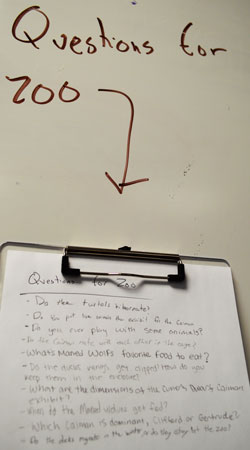
When Central High seniors Charlotte Delaney and Kristen Giles were studying the bear exhibit at John Ball Zoo earlier this school year, they noticed the bears didn’t seem to be having any fun with their food. You know, like one’s bears should.
“They just put out these huge piles of food for them, and we thought (the bears) seemed bored,” Charlotte said. “We wanted to encourage their problem-solving.”
Charlotte and Kristen created a prototype of something perfectly simple and wonderfully budget-friendly: a 4-foot log with food hidden inside that bears will have to figure out how to open.

“This way they’d have to work a little bit for it,” Charlotte explained. “They’ve got a good sense of smell and they’re very curious.”
Across the room in teacher Patti Richardson’s AP biology class, other student pairs showed off a spider monkey back-scratcher made from kitchen scrub brushes, a plastic eaves basin slide for the river otters, a “banana-in-a-box” that chimpanzees have to match the shape of a lever to an opening in order to get, and a barn owl mouse-hunting maze, to name a few.

The project is part of a collaboration among the district, the zoo and the Grand Rapids Public Museum, which brings animal artifacts to the district’s zoo day. For this particular effort, biology teachers at Central and Eastern high schools involved some 400 students — mostly freshmen biology and senior AP biology — in designing new animal and enhancements for existing ones.
Students were assigned animals to research, then visited the zoo to observe and take notes on how the animals use the spaces. They worked in pairs, in the case of AP Bio students, or groups of four and five freshmen to propose improvements.
Project engages students in real-world zoo problems
Teacher Kristy Butler said the project — which involved coordinating 11 sections of biology — “really focuses on some of the engineering practices in the Michigan (Next Generation) Science Standards” study of natural selection and ecology.

“The work (students) are doing is really impressive,” she said. “It’s a lot of fun to see the kids that are typically more reserved get so enthused about this.”
Freshmen in Jason Colegrove’s biology class at Central High worked in groups to brainstorm, prototype and construct interactive placards and exhibits for their assigned animals, taking into account species adaptation and behavior as well as zoo visitors and staff.
Those students presented their ideas to classmates and judges, and wrote essays that included justifications for their work based on their research.
In one classroom, zoo animal ambassador coordinator Kara Loney filled out in-depth evaluations of student presentations.
Loney nodded as one group described the thinking behind the feeding holes and drainage system of their proposed caiman exhibit that would maintain their visibility to zoo visitors while at the same time satisfy their hiding instinct.

Another group proposed a “flamingo fixer-upper” that would increase space in the current exhibit, offer more shelter and add vegetation.
“We tell them their designs might not be feasible for an entire redesign of the exhibit, but that parts of their ideas could be used,” Butler said.
Teachers in 11 sections of district biology worked to include the zoo challenge in some form, Butler said. She and Richardson led a professional development in September for teachers from across the state who hope to develop similar partnerships with their local zoos.
“This project has given them a real-world application to work on that shows them that the work they are doing in class is important, that it matters.”
CONNECT















